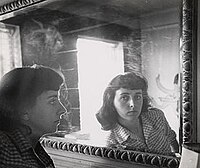Esther Bubley
| Esther Bubley | |
|---|---|

Esther Bubley, self-portrait c. 1950
|
|
| Born |
February 16, 1921 Phillips, Wisconsin |
| Died | March 16, 1998 (aged 77) New York City, New York |
| Occupation | American photographer |
| Spouse(s) | Edwin Locke (Divorced) |
| Parent(s) | Louis and Ida Bubley |
Esther Bubley (1921–1998) was an American photographer who specialized in expressive photos of ordinary people in everyday lives.
Esther Bubley was born February 16, 1921 in Phillips, Wisconsin, the fourth of five children of Russian Jewish immigrants Louis and Ida Bubley. In 1936, while Esther was a senior at Central High School in Superior, Wisconsin, the photo magazine Life first hit the newsstands. Inspired by the magazine, and particularly by the pictures of the Great Depression produced by the Farm Security Administration, she developed a passion for photojournalism and documentary photography. As editor-in-chief of the yearbook, she sought to emulate the style of Life. After high school, Esther spent two years at Superior State Teachers College (now the University of Wisconsin–Superior) before enrolling in the one-year photography program at the Minneapolis School of Art (now the Minneapolis College of Art and Design).
After college in 1941, Bubley moved to Washington, D.C. seeking work as a photographer. Failing to find a job in Washington, Bubley moved to New York City. During the 1941 Christmas season, she landed a position at Vogue in New York, but she didn't like the work. Early in 1942, she returned to Washington when she was offered a job as a microfilmer for the National Archives and Records Administration.
In the fall of 1942, Roy Stryker hired her as a darkroom assistant at the Office of War Information (OWI), where his photographic unit had recently been transferred from the Farm Security Administration. With the encouragement of Stryker and some of the more senior photographers she moved to taking pictures for the OWI historical section, documenting life on the home front during the war. Her most challenging assignment was a noted series on the bus system in the Midwest and South.
...
Wikipedia
